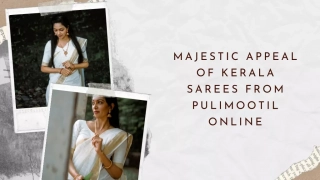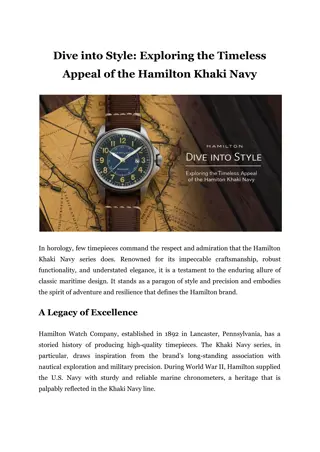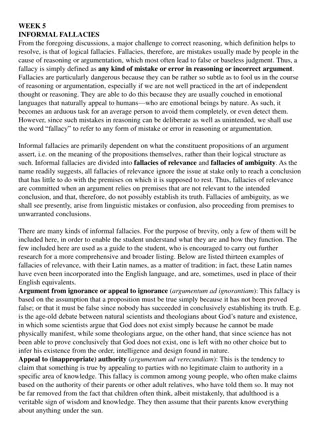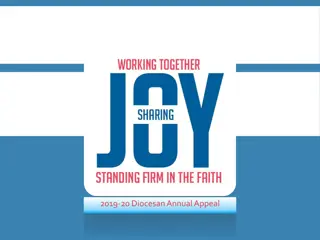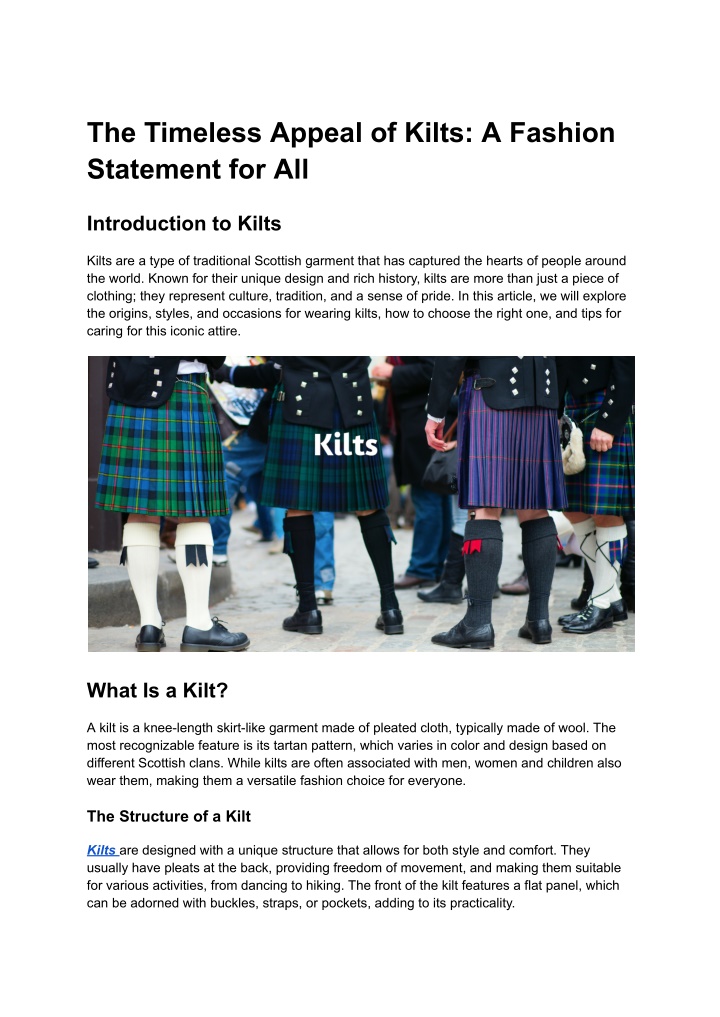
The Timeless Appeal of Kilts
The Timeless Appeal of Kilts
Download Presentation

Please find below an Image/Link to download the presentation.
The content on the website is provided AS IS for your information and personal use only. It may not be sold, licensed, or shared on other websites without obtaining consent from the author. If you encounter any issues during the download, it is possible that the publisher has removed the file from their server.
You are allowed to download the files provided on this website for personal or commercial use, subject to the condition that they are used lawfully. All files are the property of their respective owners.
The content on the website is provided AS IS for your information and personal use only. It may not be sold, licensed, or shared on other websites without obtaining consent from the author.
E N D
Presentation Transcript
The Timeless Appeal of Kilts: A Fashion Statement for All Introduction to Kilts Kilts are a type of traditional Scottish garment that has captured the hearts of people around the world. Known for their unique design and rich history, kilts are more than just a piece of clothing; they represent culture, tradition, and a sense of pride. In this article, we will explore the origins, styles, and occasions for wearing kilts, how to choose the right one, and tips for caring for this iconic attire. What Is a Kilt? A kilt is a knee-length skirt-like garment made of pleated cloth, typically made of wool. The most recognizable feature is its tartan pattern, which varies in color and design based on different Scottish clans. While kilts are often associated with men, women and children also wear them, making them a versatile fashion choice for everyone. The Structure of a Kilt Kilts are designed with a unique structure that allows for both style and comfort. They usually have pleats at the back, providing freedom of movement, and making them suitable for various activities, from dancing to hiking. The front of the kilt features a flat panel, which can be adorned with buckles, straps, or pockets, adding to its practicality.
The History of Kilts Kilts date back to the 16th century in Scotland, originating as a functional garment for Highland men. Initially, they were long garments known as "great kilts" that wrapped around the body, providing warmth and protection against the harsh Scottish weather. These early kilts were made from wool and featured a simple tartan pattern. Evolution Over Time As time went on, the design evolved into the knee-length version we know today, commonly referred to as the "modern kilt." This shorter style became popular in the 18th century and was embraced by various military regiments. The kilt became a symbol of Scottish identity, particularly during the Romantic period when interest in Scotland's heritage and culture surged. The Cultural Significance of Kilts Kilts hold deep cultural significance in Scotland. They are often worn during national celebrations, such as Burns Night and St. Andrew s Day. Additionally, kilts are an integral part of traditional Scottish music and dance, often seen at ceilidhs (traditional Scottish social gatherings). The tartan patterns used in kilts are tied to specific Scottish clans, representing family lineage and heritage, making them even more meaningful. When to Wear a Kilt Kilts are suitable for various occasions, making them a versatile addition to any wardrobe: 1. Weddings: Many grooms choose to wear kilts on their special day, often matching the tartan to their wedding theme. Guests may also wear kilts to show their support and embrace the festive atmosphere. 2. Highland Games: These traditional Scottish events celebrate athleticism and culture, with competitions such as caber tossing and tug-of-war. Wearing a kilt at the Highland Games shows your appreciation for the tradition and enhances the festive spirit. 3. Festivals and Parades: Whether celebrating St. Andrew s Day, participating in local festivals, or marching in parades, kilts make a festive statement. They create a sense of camaraderie among participants and spectators alike. 4. Everyday Wear: Many people enjoy wearing kilts casually, combining them with modern fashion for a unique look. Pairing a kilt with a simple t-shirt or a fitted sweater can create a stylish and comfortable outfit for daily activities. 5. Formal Events: Kilts can also be worn at formal events, such as charity balls or gala dinners. By accessorizing with a formal jacket, tie, and shoes, you can elevate your kilt to suit any upscale occasion. How to Choose the Right Kilt
When selecting a kilt, there are several factors to consider: 1. Material While traditional kilts are made from wool, various materials are available, including cotton and synthetic options. Wool is ideal for colder climates and formal occasions, while lighter fabrics may suit warmer weather or casual wear. 2. Size Getting the right fit is essential for comfort and style. Make sure to measure your waist and the length you prefer for your kilt. Many kilts come with adjustable straps for a customizable fit. 3. Tartan Pattern The tartan pattern is perhaps the most recognizable aspect of a kilt. Choose a pattern that resonates with you or represents your heritage. Many retailers offer a wide range of tartans, so take your time to find one that speaks to you. 4. Style and Accessories Kilts come in various styles, from traditional to contemporary designs. Consider what suits your personality and the occasions you ll be attending. Accessories like sporrans (small bags worn at the front), belts, and hose (socks) can enhance your overall look. Caring for Your Kilt To keep your kilt looking its best, follow these care tips: 1. Dry Clean Only Wool kilts should be dry-cleaned to maintain their shape and color. Avoid washing them in a machine, as this can cause shrinkage and damage to the fabric. 2. Avoid Heavy Ironing If your kilt needs freshening up, use a steam iron on a low setting to remove wrinkles. Avoid pressing too hard, as this can flatten the pleats. 3. Storage Hang your kilt in a cool, dry place to prevent damage. Using a kilt hanger or storing it in a breathable garment bag can help maintain its shape and prevent creasing. 4. Regular Inspection
Periodically check your kilt for any signs of wear and tear. Repair any loose threads or minor damage promptly to prolong its lifespan. Conclusion Kilts are a fashionable and culturally rich garment that can be worn on various occasions. Whether you're looking to embrace your Scottish heritage or simply want to try something new, a kilt is a timeless addition to any wardrobe. With their unique style, comfortable fit, and deep cultural significance, kilts are sure to make a statement wherever you go! Exploring the world of kilts opens up a realm of possibilities in fashion, identity, and heritage. So whether you're donning a kilt for a wedding, festival, or just a casual day out, you'll not only look great but also celebrate a beautiful tradition that has stood the test of time.


